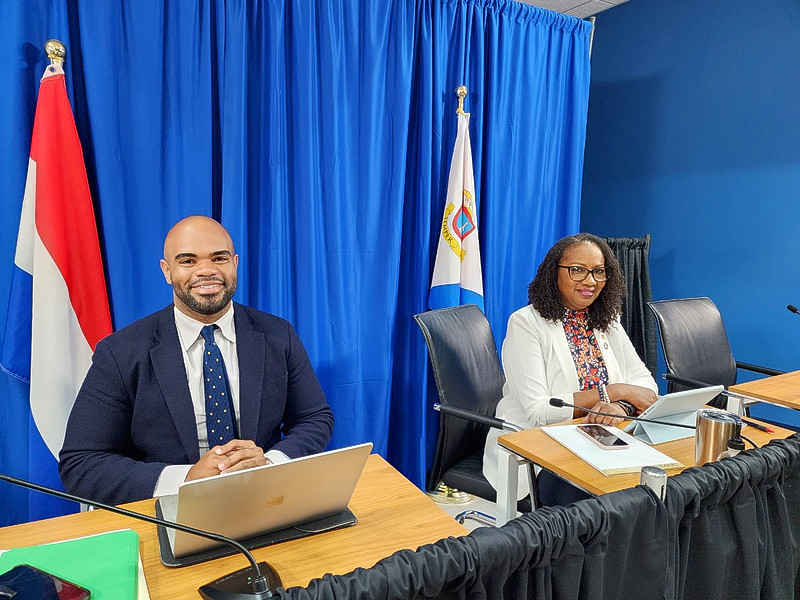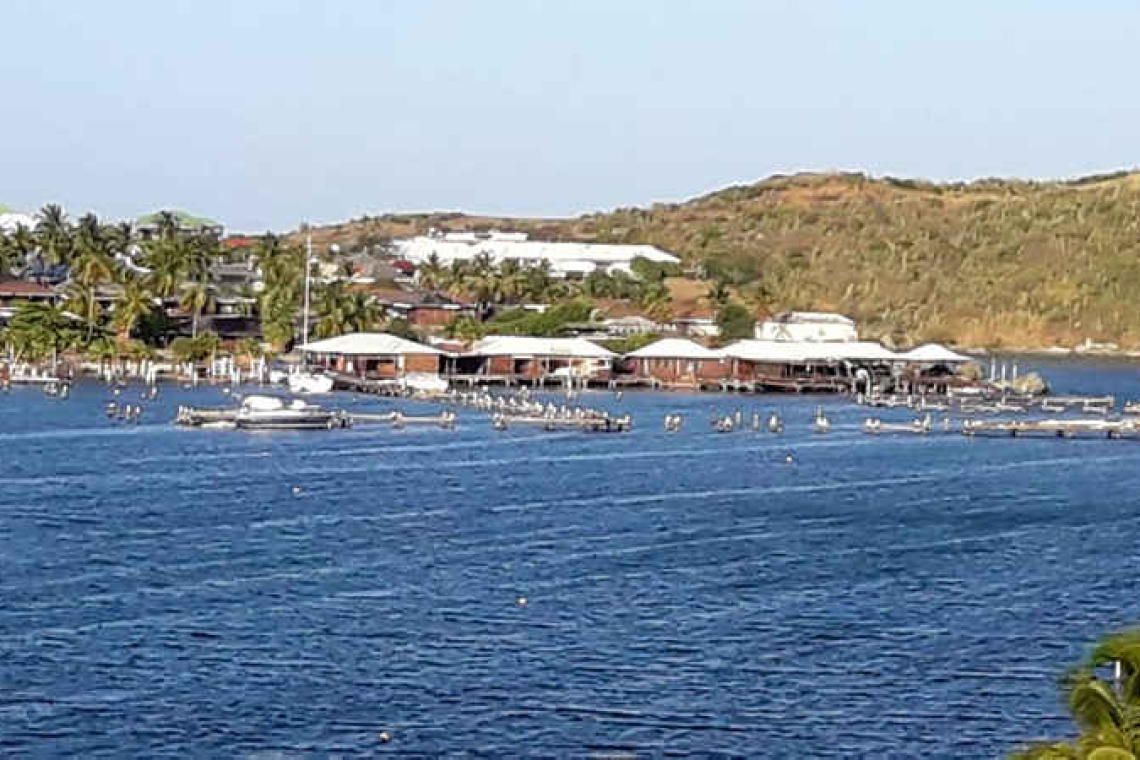A bird’s-eye view showing a section of Oyster Pond where the destroyed Captain Oliver’s is located.
~ No change in square mileage on two sides ~
PHILIPSBURG--After nine years of deliberations the French and Dutch have agreed to changes to the borderline between Dutch St. Maarten and French St. Martin, with the French gaining water rights in a section of Oyster Pond, including jurisdiction over Captain Oliver’s Restaurant and Marina, while the Dutch will gain 7,109 square metres of land mass over several border points.
The changes will not affect the current square mileage in Dutch St. Maarten (16 square miles) and French Saint Martin (21 square miles).
Technical experts are currently working on finalising the new details of the map, as there are 348 points that need to be transformed and placed on the map.
The treaty outlining the new demarcation will be signed on May 26 by Prime Minister and Minister of General Affairs Silveria Jacobs on behalf of the Kingdom of the Netherlands and Minister of the Interior Gerard Darmanin on behalf of the State of France. The treaty will take between six months to a year following the signing before entering into force.
The details of the changes were released to the media at a live press conference hosted by Jacobs and Directorate of Foreign Relations Interim Director Patrice Gumbs at the Government Building on Tuesday.
In elaborating on the changes, Jacobs told reporters that the border along the road in Cupecoy and the border along Marigot Hill Road will shift north in favour of the Dutch. The Dutch will retain authority in the Higher Bethlehem area and the border along the road in Belle Plaine will shift west in favour of the French.
Additionally, the border along the road leading to Oyster Pond will shift north in favour of the Dutch and Oyster Pond, which was the greatest contention at the time, will now be based on the principle of equidistance, which is internationally recognised, to be shared equally between French Saint Martin and Dutch St. Maarten.
Jacobs explained that the changes mainly concern public areas and therefore individuals are not impacted, as it is either public land or it belongs to the same families on both sides.
“The largest change is in Oyster Pond: the border now runs through the middle of the pond, thereby giving equal share of the water to both sides. The southern part of Oyster Pond will be retained by St. Maarten (Kingdom of the Netherlands) and the northern part to St. Martin (French Republic). The persons that will be proportionally impacted have been informed. However, the new treaty ensures that the relevant authorities will ensure the rights of anyone impacted by the changes will be properly addressed,” she explained
As Captain Oliver’s is the only company to which Dutch St. Maarten had issued rights, the changes mean that revenue in terms of taxes, etc., from Captain Oliver’s, currently not in operation since being damaged during Hurricane Irma in 2017, will now shift to the French-side government. All the other landowners along that line do not have permission from the Dutch government to establish marinas.
Jacobs said there was therefore little legal basis for St. Maarten to “win” if the matter had gone to arbitration, hence St. Maarten opted to enter into negotiations. Arbitration is a form of alternative dispute resolution that resolves disputes outside the judiciary courts.
Gumbs added that there always had been the common belief that the Dutch government exercised authority in the entire Oyster Pond area, while government only concerned itself with Captain Oliver’s and the remainder of the persons in that area dealt completely with the French, which he said undermined St. Maarten’s claim for the control of all waters in Oyster Pond.
Background
Jacobs explained that there have been disagreements related to the border on the island since 2014. These disagreements came about when the French contested the Dutch claim over all the water in Oyster Pond. This led to several instances of direct confrontation between authorities of the two sides of the island and unfortunately strained the long-standing relationship between the two governments.
The French filed a petition with the United Nations in December 2017 signalling the existence of an international border dispute on the island. This triggered the need to come to an agreement, as the deadlock that ensued after the petition would have led to arbitration, which would not answer the need for a comprehensive approach to the entire border. November 2021 saw the government of Dutch St. Maarten adopt a more compromise-driven approach that proved to advance discussions and move the island closer towards the end goal.
“Following nine years of deliberation, we will finally put to rest the border issue on Saint Martin. Technical experts are working diligently to finalise the new iteration of our map, as there are 348 points that need to be transformed and placed on the map,” said Jacobs.
She stressed that the realisation of the treaty legally establishes the boundaries of the southern and northern territories of the island, but does not undermine the oneness and unity that is spoken of among the people who call this island home. “The realisation of this treaty, in fact, has several benefits for all citizens of our island. Clarity on the borderline removes ambiguity and facilitates our long-term planning and development,” said Jacobs.
She stressed also that the treaty will be advantageous for cross-border cooperation.
“Re-engagement on the border has led to reopening of a broader French-Dutch relationship and cooperation in areas that will benefit the population – education, health, and security agreements are slated to be signed next month, for example.
“The treaty makes provisions for the establishment of a joint border commission and a cooperation platform to facilitate the continued cooperation between the governments on both sides.
“The treaty also makes provisions to promote cooperation on all cross-border land and inland waterway connections of common interest. In the negotiations, Dutch St. Maarten is ensured the right to access, freedom of navigation, mooring, freedom to conduct artisanal fishing in both Simpson Bay Lagoon and Oyster Pond,” she said.
Jacobs explained earlier in the press conference that reports that an agreement had been reached on the location of the border between St. Maarten and Saint-Martin have been in the media from both Kingdom level and from France since the end of 2022. She said these public discussions were deemed premature, as the proposals had not yet gone through the proper channels of approval; the agreement had only been reached at the technical level and still had to be approved at the Ministerial level, on St. Maarten and in the Kingdom Council of Ministers.
The approval process between the two states was finalised in March this year. Jacobs said she had found it prudent to wait until all documentation and steps were finalised before making any public statements.
“It is important to note that from the inception and at every stage, the government of St. Maarten was in the lead and wholly involved in determining the mandate.
“ The negotiations, as per Kingdom law, were led by the Ministry of Foreign Affairs, in collaboration with the Department of Foreign Relations, the Ministry of Defence, as well as both the local and Dutch Cadasters; along with inputs from the various Ministries including VROMI [Public Housing, Spatial Planning, Environment and Infrastructure – Ed.], TEATT [Tourism, Economic Affairs, Transport and Telecommunication] and Justice. The negotiation team consisted of representation from both the Ministry of Foreign Affairs and the Department of Foreign Relations,” she said
She promised to share the map as soon as it becomes available. Health and security agreements are slated to be signed next month, for example).
“The treaty makes provisions for the establishment of a joint border commission and a cooperation platform to facilitate continued cooperation between the governments on both sides. The treaty also makes provisions to promote cooperation on all cross-border land and inland waterway connections of common interest. In the negotiations, Dutch St. Maarten is ensured the right to access, freedom of navigation, mooring, freedom to conduct artisanal fishing in both Simpson Bay Lagoon and Oyster Pond,” she said.

Directorate of Foreign Relations Interim Director Patrice Gumbs (left) and Prime Minister and Minister of General Affairs Silveria Jacobs (right) during Tuesday’s press conference.







